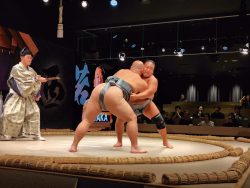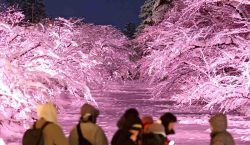
Fuwa Fukujyu Do in Toyama Prefecture sells both Domyoji sakura mochi, left, and Chomeiji sakura mochi

14:00 JST, March 14, 2023
With the cherry blossom season approaching, one gets a craving for fragrant sakura mochi, a springtime Japanese wagashi confection consisting of a mochi cake filled with red bean paste that is wrapped in a salted cherry leaf.
The cake — the part that surrounds the bean paste — is made of wheat flour in the Kanto region and glutinous rice in the Kansai region. The sweets are roughly classified as Chomeiji sakura mochi and Domyoji sakura mochi.
Availability is usually restricted to February and March, one or two months earlier than the blooming of the cherry blossoms. This allows makers to keep ahead of the season.
Riverbank origins
Sakura mochi was first made in 1717 by a man named Yamamoto Shinroku. He came to Edo — now Tokyo — from Choshi, in the province of Shimousa, which is now Chiba Prefecture. He became a gatekeeper at Chomeiji temple in Mukojima, Sumida Ward, and wanted to do something about the falling cherry leaves that kept piling up in the temple, so he pickled them in salt, wrapped them around mochi and put them on sale. The Sumida River’s bank in front of the temple was famous for its cherry blossoms, and the sweets he came up with sold very well.
The shop that first sold the mochi was Chomeiji Sakuramochi, located next to the temple. It has manufactured sakura mochi for more than 300 years through 11 generations. Sweet red bean paste is wrapped in thinly baked crepe-like white dough. The sweet flavor of the bean paste and chewy mochi complement the refreshingly sweet koshi-an, smooth red bean paste.

Sakura mochi at Chomeiji Sakuramochi in Sumida Ward, Tokyo, where the sweet was born.
Domyoji from Kansai
The aroma of cherry leaves, the moist and rich cake, the subtle saltiness and the sweetness of the bean paste made sakura mochi a hit, and its popularity spread throughout the country.
In the Kansai region, sakura mochi is made from Domyoji flour — known as hoshii — made by drying glutinous rice that has been coarsely ground and steamed.
The name “Domyoji” comes from Domyoji temple in Fujiidera, Osaka Prefecture, where a nun first created hoshii.
Tsuruya Kotobuki, a specialty store in the Arashiyama district of Kyoto, sells a typical Kansai-style sakura mochi all year round. Its Arashiyama Sakuramochi, which has grainy white cake dough made from Domyoji flour, is popular for its fine koshi-an and elegant sweetness, with an aroma of cherry leaves.

Sakuramochi by Tsuruya Kotobuki in Kyoto
2 dominant types
Sakura mochi eaten in various parts of the country can roughly be divided into two types: Chomeiji or Domyoji.
Chomeiji is commonly found in the Kanto region and the central part of Japan, known as the Koshinetsu region, as well as Iwate and Fukushima prefectures. Domyoji, whose cake has a pink tint, spread to western Japan, but is also found in Hokkaido, Aomori and Yamagata prefectures. The distribution partly coincides with the distribution channels of the Kita-maebune merchant ships that plied the Sea of Japan during the Edo period (1603-1868).
Fuwa Fukuju Dou sells confectioneries in Takaoka, Toyama Prefecture, where the nation’s eastern and western cultures meet. The shop’s president Ryotaro Fuwa said: “In Hoku-riku [a region that includes Toyama], sakura mochi is in the Domyoji style.”
Even so, Fukuju Dou’s cook learned pastry making in Tokyo and began manufacturing Chomeiji sakura mochi 10 years ago. Sales of that kind account for 30% of the total sakura mochi available at the shop today.
In Hokkaido, where cherry blossoms bloom in May, the Domyoji style is the mainstream. However, confectionary store Morimoto, based in Chitose City, does not use Domyoji flour.
According to a Morimoto spokesperson, the store makes sakura mochi by steaming glutinous rice grown in Hokkaido and makes fluffy mochi balls with koshi-an inside. The treats look Kansai-style, but they do not use Domyoji flour as an ingredient. She said it is a Morimoto original.

Sakura mochi made by Morimoto in Chitose, Hokkaido.
Japan’s largest leaf producer
Oshima cherry leaves are used for sakura mochi, as they give off a sweet fragrance when pickled in salt.
The town of Matsuzaki in the southwestern part of the Izu Peninsula of Shizuoka Prefecture accounts for 70% of the nation’s salted cherry leaf production. The town has 50 farmers who harvest the leaves from April to September. The young leaves are picked one by one by hand, and pickled in salt.

Cultivation of Oshima cherry leaves in Matsuzaki, Shizuoka Prefecture.
The second president of the town’s Baigetsuen confectionery began producing and selling Sakuraba Mochi about 50 years ago, when the then mayor was eager to make “a specialty sweet that is unique to the town boasting the largest production of cherry leaves.”
The cake of Baigetsuen’s Sakuraba Mochi is made of joshinko — top-grade rice flour made from non-glutinous rice — following the Kanto-style with koshi-an inside, and completely wrapped in a leaf. Many people eat the leaf as well, and the sweet bears a kanji word meaning “leaf” in its name.
***
Japan Tourism is presented in collaboration with The Japan News and Ryoko Yomiuri Publication, which publishes Ryoko Yomiuri, a monthly travel magazine. If you are interested in the original Japanese version of this story, click here.
"Features" POPULAR ARTICLE
-

Students Recreate 19th-Century Bento Boxes Made for Ino Tadataka’s Survey Team in Hot Spring Town on Nakasendo Road
-

Santa Claus Delivers Christmas Presents to Penguins at Aquarium in Japan’s Nagasaki Prefecture
-

Sumo Restaurant in Tokyo Teaches Foreign Visitors About the Ancient Sport, with Bouts Between Retired Rikishi
-

Autonomous Passenger Ship Connects Mainland with Remote Island in Seto Inland Sea; World’s 1st Commercially Operated Autonomous Vessel
-

Osaka’s Sumiyoshi Taisha Shrine Bustles with New Year’s Visitors
JN ACCESS RANKING
-

As Chinese Tourists Shun Japan, Hotels and Stores Suffer
-

Tokyo Economic Security Forum to Hold Inaugural Meeting Amid Tense Global Environment
-

Osaka-Kansai Expo’s Economic Impact Estimated at ¥3.6 Trillion, Takes Actual Visitor Numbers into Account
-

Japan Govt Adopts Measures to Curb Mega Solar Power Plant Projects Amid Environmental Concerns
-

BOJ Gov. Ueda: Highly Likely Mechanism for Rising Wages, Prices Will Be Maintained


























